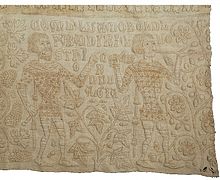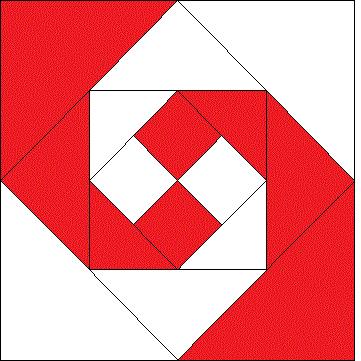Part 3: Beliefs and Meanings, Ontario block
By choice, or forced, the immigration of people to North America has left a rich legacy of quilt patterns that reflect the old world and new world. They are a record of beliefs and hopes. This next blog is about one such group.
Various symbols from secret African societies and Masonic emblems can be found in North American quilt patterns. The nine-patch, hourglass, and five pointed star can be found in both societies. The diamond or cross represented the four names of the sun or soul; birth, life, death, rebirth. The “pinwheel”, “bow tie” and “hourglass”, “flock of geese”, and light the dark squares to represent leopard spots are patterns that arrived in the new world with African slaves. The red square on African American quilts represented the mojo charm, which interestingly is also found in the centre of popular traditional log cabin pattern. Some historians believe that the tradition of memory boards, used in Africa to encode knowledge, was used by slaves in quilts to escape to Cannan (Canada). According to some, the quilt patterns represented actions to take, while the stitching was used like a topographic map. Even the number of knots used in a tie imparted information in a society where reading and writing was not permitted amongst slaves.

Harriet Powers Bible Quilt, 1885-1886
https://en.wikipedia.org/wiki/Harriet_Powers
In a group of people denied a means to convey messages through writing, some of the patterns in quilts were thought to communicate an action or a place of safety. It is not hard to imagine that the “monkey wrench” would signal the need to gather tools needed for the journey or that the waggon wheel indicated it was time to pack what you needed. The “drunkards path” reminded slaves to travel in a zigzag path to avoid pursuit; It was believed that evil also only travelled in straight lines. In addition 5 square knots were used in a quit tie for protective power and to invoke the help of ancestors. Other blocks such as “log cabin”, “shoo-fly”, “bow tie”, “cathedral church”, double wedding ring (most likely a double Irish chain), “flying geese” and “tumbling blocks” also were believed by some to have had special significance.
Other important patterns conveyed reminders to escaping slaves. The Bears Paw, told slaves to follow bear trails that would lead them to food and water. The Crossroads block represented Cleveland Ohio and a port to Canada. Jacobs ladder a symbol of the underground railway and location of supporters. The Star (North Star) and Pin Wheel showed the direction to travel, while “Trip around the World” was a reminder to travel around the mountains and not over. Whether you choose to believe African slaves conveyed messages through quilts, it is not hard to imagine that objects and ideas can become symbols used in quilts.
Since Cannan represented Canada, and Ontario in particular, this is my next quilt block province. Ontario is actually the place of my birth, the place I lived for the first 18 years of my life. It was also the place my parents chose to emigrate to after the war when skilled tradesmen were in demand in the manufacturing industry.
My memories are of the lakes with amazing beaches, red sugar maples, endless fruit orchards, and the Niagara escarpment (or “The Mountain”). Seems to me, a traditional lake or fruit basket-type block would be an easy choice. But the other thing I kept thinking about is what brought my parents here; I struggled to do so with less than fond memories of the steel mills, factories and other industries. In the end, my block for Ontario is the monkey wrench. There is no doubt that Ontario continues to be manufacturing powerhouse of Canada.
Ontario Block (monkey wrench)



Just wanted to let you know that I am reading your blogs and enjoying them.
LikeLike